After the Trump Administration’s decision to pull out of the Paris Climate Agreement, Mayor Emanuel vowed, “We are still in.” He wasn’t kidding — so far Chicago has met 40 percent of the 2025 goal — and we work toward a cleaner, healthier, and more sustainable city every day. Read on for eight incredible ways we’ve stepped up our efforts to protect the environment.
1. We’ve embraced clean energy
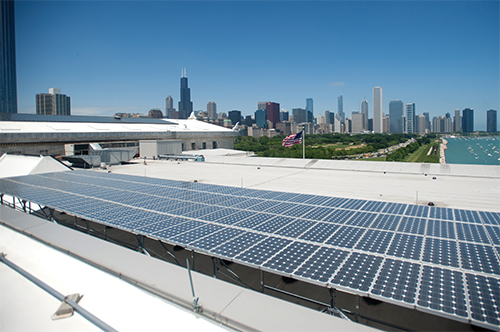
As the fastest-growing sector in the U.S., clean energy is the source of 120,000 Illinois jobs — and the momentous Future Energy Jobs Act, passed in 2016, will spur an upsurge of solar panels. (Good news: If you don’t have appropriate roof space, community solar alternatives will soon be available.) Currently, the city procures coal-free electricity, and by 2025, all Chicago public buildings will be powered by 100 percent renewable energy.
2. We’ve made “good” food a priority
As one of the nation’s top cities for urban agriculture, we have more than 500 urban farms and community gardens and 64 farmers markets spread among our neighborhoods. Gotham Greens operates the world’s largest and most productive rooftop greenhouse in Pullman, and Lawndale’s upcoming Farm on Ogden will serve as a food production and farmer-training hub, bringing fresh fruits and vegetables to food deserts. Chicago is also a hotbed of thriving food startups, including Simple Mills, MightyVine, and Phoenix Bean/Jenny’s Tofu, and the Good Food Accelerator and The Hatchery, opening this year, will help launch future enterprises.
3. We value the nature that surrounds us
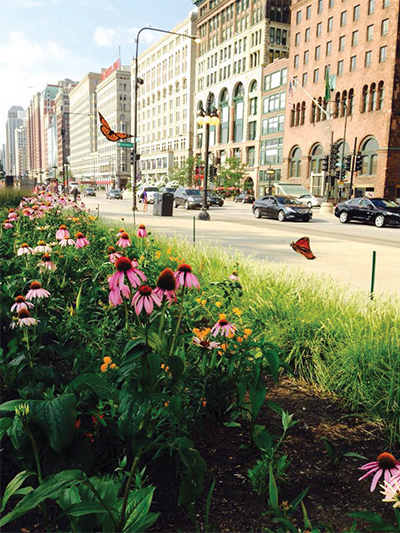
Amid a park boom, the latest nature attractions include Northerly Island, Maggie Daley Park, Big Marsh, and the Burnham Wildlife Corridor. Additionally, 327 playgrounds were created or modernized so every child lives within a 10-minute walk of a park. The city’s Building on Burnham plan aims to protect 2,020 acres of natural areas by 2020; tree-keepers work tirelessly to care for urban trees besieged by invasive buckthorn and emerald ash borers; and Field Museum scientists are promoting native milkweed in the urban landscape to help beloved monarch butterflies recover from decline.
4. We bike and walk — a lot
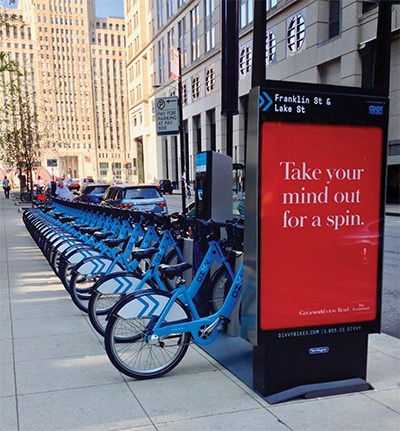
Chicago is on a roll with almost 300 miles of bike lanes, including the soon-to-be separated Lakefront Trail and a downtown network of protected bike lanes, the first in a major U.S. city. City plans call for a 645-mile biking network by 2020. Signature blue Divvy bikes, the nation’s second-biggest bike share system, are a mainstay of mobility. (Fun fact: During 2017, users took 3.8 million trips.) The system will reach 6,200 bikes at 620 stations this year, with recent expansion to the west and south sides and Evanston. According to Redfin, Chicago is the country’s sixth most most walkable city, with innovative walkways including The 606 trail and 312 RiverRun — which is being built as we speak — driving active transportation.
5. We’ve cleaned up our waterways
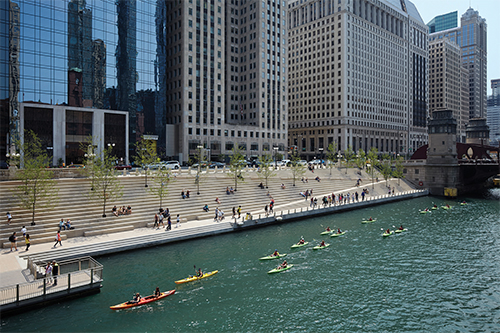
Once forgotten, the Chicago River has transformed into a recreational magnet. Accessible walkways and open park spaces draw people to the riverfront, and rowers and kayakers enjoy four new boathouses and cleaner water thanks to disinfection improvements. Lake Michigan, a treasured recreational haven, is the drinking water source for roughly 6.6 million Illinoisans — and protecting it from toxic pollutants and invasive species, such as Asian carp, remains a top priority. Illinois was the first state to ban plastic microbeads from personal care products, and Shedd Aquarium is challenging restaurants to forgo plastic straws through its “Shedd the Straw” campaign to reduce water pollution.
6. We’ve cut back on energy waste
Chicago is a 2017 Energy Star Partner of the Year for its strategies to trim energy waste, particularly a benchmarking ordinance that discloses the energy performance of large buildings. As part of the Retrofit Chicago Energy Challenge, 76 buildings covering 50 million square feet have committed to reducing their energy use by 20 percent. We currently have the greenest commercial office space in the U.S.; 66 percent of office buildings qualify as LEED or Energy Star. Several cutting-edge technological firsts have raised the bar, including Method’s first LEED Platinum Factory, Walgreens’ first net energy store, and the Tierra Linda affordable housing development featuring green technology and a passive house.
7. We’ve improved our public transportation
Chi-town commuters get around with less traffic and pollution than ever before. Each year, passengers take nearly 500 million rides on the CTA’s multicolored “L” lines and buses and 80 million trips on Metra trains. Elon Musk’s Boring Company and other firms just submitted proposals to build and operate a 20-minute express train from Block 37 downtown to O’Hare; the CTA plans to purchase 20 to 30 electric buses this year; and options to charge electric vehicles will soon expand.
8. We cultivate eco-savvy students
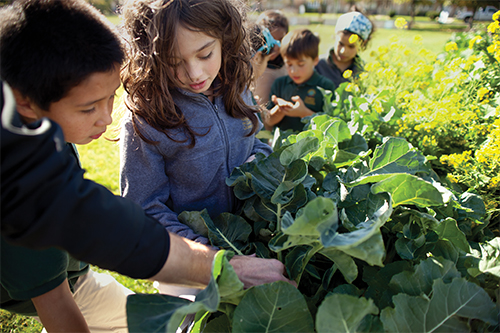
Chicago is home to many standout green schools: The Forest Playschool is an entirely outdoor nature preschool, while the Chicago High School for Agricultural Sciences offers college prep on a working farm. Loyola University is ranked the nation’s seventh greenest college by the Sierra Club, and the Academy for Global Citizenship plans to build a revolutionary net-positive-energy urban farm campus. Thanks to amazing nonprofits like Big Green, learning gardens are currently being planted at 200 CPS schools, while Space to Grow is busy converting asphalt lots to green schoolyards at 34 more. At the same time, youth programs teaching sustainability — including Sacred Keepers, GreenCorps, and Windy City Harvest Youth Farm, one of the Chicago Botanic Garden’s urban initiatives, are cropping up all over the city.
 Amanda Hanley is the Co-Founder and Co-Director of the Hanley Foundation, and has been working to advance sustainable solutions for several decades. She currently serves on the NRDC’s Midwest and Global Leadership Councils, the Academy for Global Citizenship (a green Chicago Public Charter School), the Global Catholic Climate Movement, As You Sow (promoting corporate accountability), North Shore Green Women, and Chicago Women in Green. She helped found and advises the University of Dayton’s Hanley Sustainability Institute and also serves on the advisory board of Loyola University Chicago’s Institute for Environmental Sustainability.
Amanda Hanley is the Co-Founder and Co-Director of the Hanley Foundation, and has been working to advance sustainable solutions for several decades. She currently serves on the NRDC’s Midwest and Global Leadership Councils, the Academy for Global Citizenship (a green Chicago Public Charter School), the Global Catholic Climate Movement, As You Sow (promoting corporate accountability), North Shore Green Women, and Chicago Women in Green. She helped found and advises the University of Dayton’s Hanley Sustainability Institute and also serves on the advisory board of Loyola University Chicago’s Institute for Environmental Sustainability.

